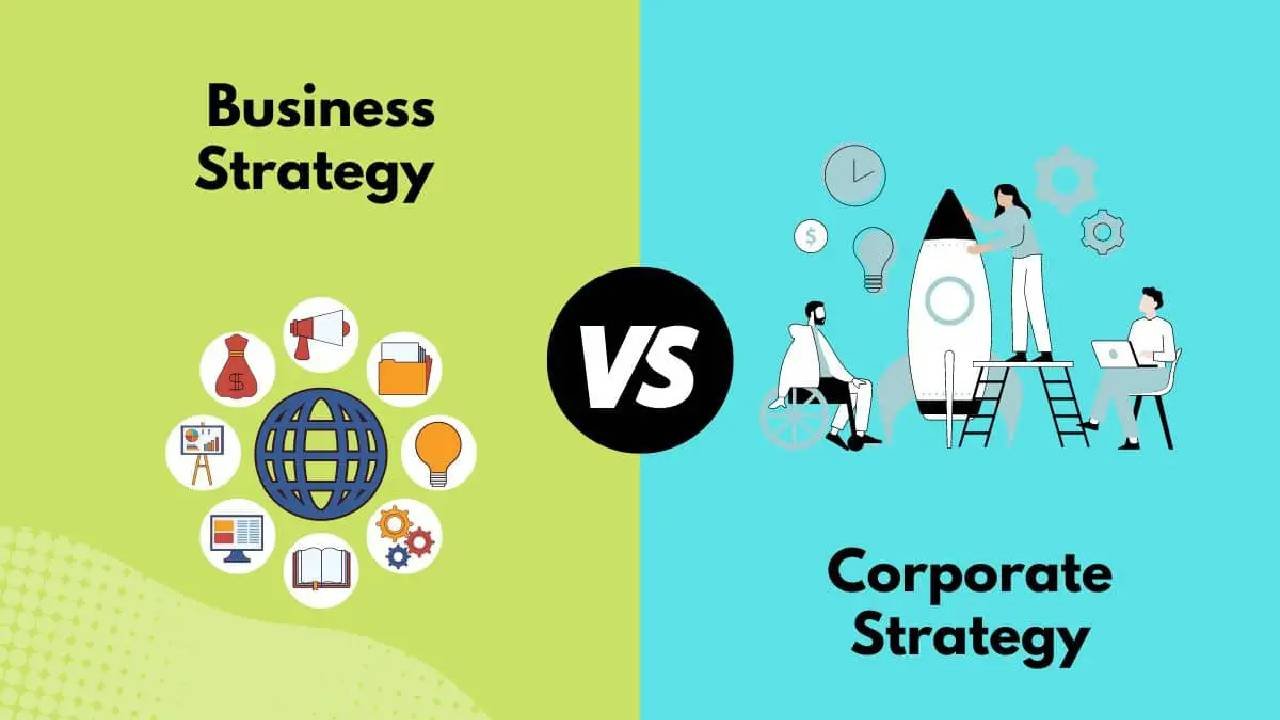Embarking on the journey to organizational triumph requires a nuanced comprehension of the intricate interplay between “Corporate Strategy vs Business Strategy.” In the realm of strategic planning, these terms serve as the cornerstones, each bearing a unique imprint on the trajectory of success.

Unlike mere buzzwords, Corporate Strategy and Business Strategy are pivotal components that shape the destiny of enterprises. This exploration aims to unravel the distinctions between them, dissecting the foundational elements that set Corporate Strategy apart from its business-oriented counterpart.
As we navigate through this strategic terrain, it becomes evident that the success of an organization hinges on decoding the intricate dance between Corporate Strategy and Business Strategy, each playing a distinct yet interdependent role in the grand symphony of achievement.
Let’s delve into the intricacies of these strategic frameworks, shedding light on the pathways to triumph in the corporate landscape.
Defining Corporate Strategy
In the intricate tapestry of organizational success, “Defining Corporate Strategy” emerges as a pivotal chapter, a compass guiding enterprises through the complex terrain of corporate landscapes. Unlike business strategies that may focus on specific projects or departments, Corporate Strategy encapsulates the broader vision, serving as the architect of an organization’s overarching direction.
In this exploration, we unravel the layers of Corporate Strategy, dissecting what sets it apart in the grand scheme of organizational planning. From the panoramic view it provides to the meticulous alignment of vision and mission, Corporate Strategy establishes the framework upon which an organization’s success is built.
The Big Picture: What Sets Corporate Strategy Apart?
Corporate Strategy, unlike its more granular counterparts, is the panoramic lens through which organizations survey the vast landscape of possibilities and challenges.
It rises above everyday tasks, offering an elevated perspective of the whole undertaking. Choosing impacts the association overall, from market situating to asset portion.
In essence, Corporate Strategy sets the stage for sustained success by charting the course that all business strategies and operations will follow. It’s the difference between steering a ship in open waters and managing the crew within its cabins.
Aligning Vision and Mission: Core Elements of Corporate Strategy
At the heart of Corporate Strategy lies the essential task of aligning the vision and mission of an organization. The vision serves as the guiding star, painting a vivid picture of the desired future, while the mission outlines the practical steps to reach that destination.
Corporate Strategy acts as the compass that ensures these two critical elements are not just lofty ideals but actionable roadmaps. The alignment of vision and mission in Corporate Strategy is the bedrock upon which the entire organizational structure rests.
It’s the cohesive force that unites the diverse functions and departments, ensuring that every action contributes to the realization of the overarching goals. In essence, Corporate Strategy is the orchestrator, harmonizing the symphony of an organization’s purpose with the practicality of its execution.
This deliberate alignment, integral to Corporate Strategy, contrasts with the more specific and immediate objectives often found in business strategies. While business strategies are essential for day-to-day operations, Corporate Strategy provides the overarching framework that gives those operations purpose and direction. It’s the glue that binds the micro and macro elements of organizational success.
Exploring Business Strategy
As we navigate the intricate landscapes of organizational success, the spotlight now turns to “Exploring Business Strategy,” a critical facet in the strategic tapestry that defines triumph in the corporate realm.
Unlike Corporate Strategy, which paints the broad strokes of an organization’s direction, Business Strategy takes center stage in the tactical theater, honing in on the specific moves that propel enterprises forward.
In this exploration, we delve into the dynamics of Business Strategy, examining how it deftly navigates markets and strategically maneuvers through the challenges and opportunities that shape the corporate landscape.
From market-centric decisions to the tactical components that form the backbone of success, Business Strategy emerges as the linchpin that converts visions into measurable actions.
Navigating the Markets: How Business Strategy Takes Center Stage
Business Strategy, with a laser focus on markets, emerges as the compass guiding organizations through the ever-evolving landscapes of commerce. It involves a meticulous analysis of market dynamics, competition, and consumer behavior.
Unlike Corporate Strategy, which views the organization as a whole, Business Strategy hones in on specific market segments and niches. It’s the roadmap that guides enterprises in positioning themselves strategically, seizing opportunities, and mitigating risks within the market ecosystem.
Through a proactive approach, Business Strategy ensures that organizations not only navigate the currents of competition but also chart a course that leads to market leadership.
In the grand comparison of Corporate Strategy vs Business Strategy, the latter stands as the agile navigator, steering the ship through the intricate waters of the business world.
Tactical Moves: Components of a Robust Business Strategy
The essence of Business Strategy lies in its ability to make tactical moves that form the building blocks of success. From product development to pricing strategies, these components are the gears that drive the machinery of the organization forward.
In contrast to the broader strokes of Corporate Strategy, Business Strategy involves hands-on, day-to-day decision-making. It encompasses a myriad of tactical moves, including market positioning, branding, and resource allocation at a micro level.
A robust Business Strategy is like a well-choreographed dance, where every move is purposeful and contributes to the overall rhythm of success. It’s about seizing opportunities at the moment, adapting to market changes, and staying ahead in the competitive race.
While Corporate Strategy sets the overarching direction, Business Strategy executes the tactical maneuvers that ensure an organization not only survives but thrives in the competitive arena.
In the grand interplay of Corporate Strategy vs Business Strategy, it’s the tactical acumen of the latter that positions organizations as agile players in the business chessboard.
Corporate Strategy vs Business Strategy – Key Differentiators
As we traverse the strategic landscape, the spotlight now falls on the critical juncture of Key Differentiators, the nuanced elements that set Corporate Strategy apart from its business-centric counterpart.
In this exploration, we dissect the distinguishing features that carve a unique identity for each. Beyond the broad strokes of organizational direction and tactical maneuvers, Corporate Strategy and Business Strategy reveal their true colors in the realms of scope, scale, and market dynamics.
Understanding these key differentiators is not merely an exercise in semantics but a crucial insight into the strategic DNA that propels organizations toward triumph.
Let’s delve into the intricacies of these differentiators, unraveling the essence that defines the grand interplay between Corporate Strategy vs Business Strategy.
Scope and Scale: Distinguishing Features of Corporate Strategy
At the heart of the differentiation between Corporate Strategy and Business Strategy lies the scope and scale of their influence.
- Corporate Strategy operates on a grand canvas, encompassing the entire organization and its diverse components. It’s about making decisions that impact the organization as a whole, from overarching goals to the allocation of resources.
- The scope of Corporate Strategy extends beyond the immediate concerns of individual departments, painting a holistic picture of the company’s future. On the other hand, Business Strategy, while vital, operates at a more focused level. It addresses the specific needs and challenges of individual business units or product lines, catering to the microcosm within the broader corporate landscape.
Understanding the scope and scale is paramount in deciphering the strategic language of success, where Corporate Strategy charts the course for the entire ship, while Business Strategy fine-tunes the sails for each segment’s journey.
Market Dynamics: Where Business Strategy Holds Its Ground
In the grand theater of corporate strategy, the dynamics of the market emerge as a defining arena where the battle between Corporate Strategy vs Business Strategy unfolds.
- Market dynamics represent the ebb and flow of consumer behavior, competition, and external forces that shape the business landscape. While Corporate Strategy provides the overarching vision, it is within the intricate tapestry of market dynamics that Business Strategy truly holds its ground.
- Business Strategy is the agile player, adapting to the ever-changing market forces, seizing opportunities, and mitigating risks. It’s the strategic dance within the marketplace, where decisions on pricing, product positioning, and customer engagement become pivotal moves. While Corporate Strategy sets the general direction.
- Business Strategy navigates the turbulence of market dynamics, ensuring that the organization remains not only resilient but also responsive to the evolving needs of its audience.
In the grand comparison of Corporate Strategy vs Business Strategy, it’s in the market dynamics that the true differentiators come to light, showcasing the complementary roles each plays in the pursuit of corporate triumph.
Integration and Alignment
In the intricate dance of organizational success, the pivotal chapter of Integration and Alignment takes center stage, unraveling the symbiotic relationship between Corporate Strategy and Business Strategy.
This exploration delves into the interconnectedness that binds these strategic frameworks, forging a harmonious path toward triumph in the corporate realm. Beyond the mere coexistence of these strategies, their integration and alignment become the linchpin for optimal results.
As we navigate through the complexities of their interplay, it becomes evident that the synergy between Corporate Strategy vs Business Strategy is not just a strategic partnership but a dynamic force that propels organizations towards unparalleled success.
The Symbiosis: How Corporate and Business Strategies Interconnect:
At the heart of organizational success lies the symbiotic relationship between Corporate Strategy and Business Strategy. These two strategic frameworks do not operate in isolation but rather intricately interconnect to create a synergistic whole. Corporate Strategy, with its broad strokes and overarching vision, sets the stage for the organization’s direction.
Meanwhile, Business Strategy, operating at a more granular level, aligns itself with this broader vision. It interprets and translates the grand objectives of Corporate Strategy into actionable plans at the micro level.
This interconnection forms the backbone of strategic decision-making, ensuring that every move made at the business level resonates with and contributes to the larger organizational goals.
The symbiosis between Corporate and Business Strategies is akin to a well-choreographed dance, where each partner complements the other’s moves, creating a harmonious rhythm that leads the organization toward unified success.
Achieving Harmony: Aligning Goals for Optimal Results:
Harmony in the strategic landscape is achieved through the meticulous alignment of goals between Corporate and Business Strategies. While Corporate Strategy sets the overarching goals and objectives for the entire organization, Business Strategy aligns its goals with this broader vision.
It’s not merely a matter of coherence; it’s about creating a seamless integration where every business unit and operational facet works in concert toward the realization of the corporate vision.
Achieving harmony involves ensuring that the specific goals and initiatives devised at the business level are in direct alignment with the broader strategic objectives laid out by Corporate Strategy.
This alignment is the catalyst for optimal results, creating a synchronized and efficient organizational machinery. The harmonious interplay between Corporate Strategy vs Business Strategy, characterized by shared goals and aligned efforts, becomes the driving force that propels organizations toward strategic excellence and lasting success.
Decision-Making Processes
In the intricate tapestry of organizational dynamics, the realm of “Decision-Making Processes” stands as a critical chapter, illuminating the strategic pathways shaped by Corporate Strategy and Business Strategy.
The decision-making processes within an organization are not only a reflection of its strategic intent but also the manifestation of the interplay between these two vital frameworks.
From the boardrooms where the sweeping decisions of Corporate Strategy are formulated to the frontlines where Business Strategy is executed with precision, this exploration delves into the intricacies of how strategic decisions are crafted and implemented.
As we navigate through the corridors of power and the operational frontlines, the distinct roles of Corporate Strategy vs Business Strategy in the decision-making processes become apparent, showcasing their unique contributions to the orchestration of organizational success.
From Boardrooms to Departments: Corporate Strategy in Action:
The decision-making processes within an organization often find their genesis in the boardrooms, where Corporate Strategy takes center stage. In these high-level discussions, the grand vision of the organization is crafted, and strategic objectives are delineated.
Corporate Strategy, operating on a broad canvas, sets the overarching direction that guides decisions across departments. It involves choices that impact the entire organization, from resource allocation to market positioning.
The decision-making process in the boardrooms becomes the nexus where the grand intent of Corporate Strategy is transformed into actionable directives for the entire organizational landscape.
While boardrooms set the tone for strategic decisions, Corporate Strategy ensures that these decisions resonate with the overarching goals, fostering a cohesive and unified direction for the entire enterprise.
Executing Precision: Business Strategy on the Frontlines:
While the boardrooms conceive the strategic intent, it is on the frontlines where Business Strategy comes into play, executing decisions with precision.
Business Strategy, operating at a more granular level, takes the directives set by Corporate Strategy and translates them into tangible actions. It involves decision-making processes that address the specific needs and challenges of individual business units or departments.
Whether it’s product development, marketing strategies, or day-to-day operations, Business Strategy ensures that every move aligns with the broader strategic objectives.
The decision-making precision on the front is a testament to the agile and adaptive nature of Business Strategy, responding to market dynamics and operational nuances.
In the grand interplay of Corporate Strategy vs Business Strategy, the decision-making processes unfold as a collaborative dance, where the strategic intent crafted in the boardrooms finds its realization through the meticulous execution on the front.
Adaptability in a Dynamic Environment
In the ever-evolving landscape of business, the ability to adapt becomes the hallmark of sustainable success. Adaptability in a Dynamic Environment serves as the compass guiding organizations through the tumultuous seas of change.
This exploration delves into the strategic acumen required in navigating shifts, where the roles of Corporate Strategy and Business Strategy become pronounced.
From the overarching decisions made in times of change by Corporate Strategy to the nimble responsiveness exhibited by Agile Business Strategies on the frontlines, adaptability emerges as a defining trait in the corporate realm.
As we traverse through the transformative currents, the distinct contributions of Corporate Strategy vs Business Strategy in fostering adaptability shine forth, demonstrating their unique roles in steering organizations through the unpredictable tides of a dynamic business environment.
Corporate Strategy in Times of Change:
When change looms on the horizon, Corporate Strategy steps into the spotlight as the guiding force that shapes the organization’s response. In times of upheaval, such as technological shifts, market disruptions, or global events, Corporate Strategy becomes the bedrock upon which the organization relies for stability.
Decisions made at the corporate level during these critical junctures set the course for adaptability. Corporate Strategy assesses the situation, recalibrates overarching goals, and devises a strategic roadmap that steers the organization through turbulent times.
Whether it involves repositioning in the market, restructuring operations, or embracing innovative technologies, Corporate Strategy serves as the lighthouse guiding the ship through the storm, ensuring that the organization not only survives but thrives in the face of change.
Agile Business Strategies: Responding to Market Shifts:
In the face of a dynamic environment, the execution of adaptability falls into the hands of Agile Business Strategies operating on the frontlines. Business Strategy, with its granular focus and operational agility, responds to market shifts with nimbleness and precision. This involves real-time decision-making, adjustments to product offerings, marketing strategies, and operational procedures.
Agile Business Strategies, attuned to the nuances of the market, act as the frontline responders, swiftly adapting to changing consumer preferences and industry trends.
While Corporate Strategy sets the overarching direction, it is the adaptability exhibited by Business Strategy that ensures the organization remains resilient and responsive to the ever-changing dynamics of the business landscape.
In the grand interplay of Corporate Strategy vs Business Strategy, it is the harmonious collaboration of their roles in times of change that propels organizations towards enduring success in a dynamic environment.
Challenges and Solutions
In the labyrinth of organizational strategies, the chapter on “Challenges and Solutions” emerges as a critical narrative, unveiling the hurdles that organizations face in the corporate landscape. The strategic journey, marked by the interplay of Corporate Strategy and Business Strategy, is not without its trials.
This exploration navigates through the complexities of these challenges, shedding light on the stumbling blocks encountered in the pursuit of triumph. From the broad challenges faced on the corporate landscape to the pitfalls specific to business strategy, the examination of hurdles and their solutions becomes a guidebook for organizations seeking to fortify their strategic armor.
As we unravel the intricacies, the distinct roles of Corporate Strategy vs Business Strategy in surmounting these challenges come to the forefront, painting a dynamic picture of resilience and strategic acumen.
Hurdles on the Corporate Landscape:
The corporate landscape is riddled with challenges that demand astute navigation. From economic uncertainties to geopolitical shifts, organizations face hurdles that can disrupt the strategic equilibrium.
Understanding the challenges of the corporate landscape is crucial in deciphering the strategic language of success. Case studies reveal instances where organizations grappled with external forces, such as regulatory changes or technological disruptions, affecting the efficacy of their Corporate Strategy.
Whether it’s the need for flexibility in the face of unforeseen events or the demand for foresight to anticipate market shifts, overcoming the hurdles on the corporate landscape requires a delicate balance between strategic intent and adaptability.
In the grand comparison of Corporate Strategy vs Business Strategy, it is in acknowledging and addressing these overarching challenges that organizations fortify their foundations for strategic resilience.
Overcoming Business Strategy Pitfalls:
The implementation of Business Strategy, while essential, is not without its pitfalls. These pitfalls can range from misaligned tactical moves to a lack of responsiveness in dynamic markets.
Examining the specific challenges faced at the business strategy level unveils the vulnerabilities that organizations encounter in their day-to-day operations. Whether it’s a failure to adapt to changing consumer preferences or a lack of agility in response to competitive moves, business strategy pitfalls demand proactive solutions.
Case studies offer glimpses into instances where organizations successfully navigated these challenges, showcasing the importance of strategic foresight and operational adaptability. Overcoming business strategy pitfalls is not only about rectifying immediate issues but also about fortifying the organization against future uncertainties.
In the intricate interplay of Corporate Strategy vs Business Strategy, the solutions devised at the business strategy level become the tactical maneuvers that ensure organizational agility and sustained success in the face of operational hurdles.
The Future Landscape
As the business horizon stretches into the future, the chapter of “The Future Landscape” beckons, offering a glimpse into the evolving tapestry of corporate and business strategies. In this exploration, we peer into the crystal ball of strategic foresight, seeking to discern the contours of what lies ahead.
The dynamics of Corporate Strategy vs Business Strategy are destined to undergo transformation, shaped by emerging trends and the need for innovation and resilience. This journey through the future landscape is not just an exercise in prediction; it is a strategic compass guiding organizations to navigate the challenges that tomorrow holds.
As we traverse through the realms of evolving trends and the imperative of innovation and resilience, the future landscape emerges as a canvas where the strategic interplay becomes even more pivotal in steering organizations toward enduring success.
Evolving Trends: What Lies Ahead for Corporate and Business Strategies?
The future landscape of corporate and business strategies is inherently tied to the currents of evolving trends. These patterns, whether driven by mechanical headways, changes in purchaser conduct, or worldwide financial changes, significantly affect the essential decisions associations should make.
Understanding what lies ahead includes a sharp familiarity with these patterns and their suggestions. Whether it’s the rise of sustainability as a business imperative or the integration of artificial intelligence in corporate decision-making, Corporate Strategy must adapt to the evolving landscape.
Similarly, Business Strategy needs to align with these trends at a more granular level, adjusting product offerings, marketing approaches, and operational processes accordingly. Navigating the future landscape demands not only an understanding of current trends but also the agility to respond and capitalize on emerging opportunities.
In the dynamic interplay of Corporate Strategy vs Business Strategy, organizations chart a course that aligns with the trajectory of evolving trends, ensuring strategic relevance and resilience in the years to come.
Innovation and Resilience: Navigating Future Challenges:
In the face of an uncertain future, innovation and resilience emerge as beacons guiding the strategic journey. The future landscape is sure to present challenges, and the ability to navigate these challenges will depend on the innovation embedded in Corporate and Business Strategies.
Corporate Strategy, as the architect of the organizational vision, must foster a culture of innovation that permeates every facet of the organization. Whether it’s embracing disruptive technologies or reimagining business models, innovation becomes the key driver of future success. On the front, Business Strategy must be resilient, capable of adapting to unforeseen challenges and bouncing back from setbacks.
The future landscape demands strategic foresight to anticipate and navigate challenges, but it also necessitates the resilience to weather storms and emerge stronger.
In the intricate dance of Corporate Strategy vs Business Strategy, innovation and resilience become the twin pillars that elevate organizations above the uncertainties of the future, ensuring not only survival but sustained success in the evolving business landscape.
Conclusion
In the intricate choreography of organizational triumph, the interplay of Corporate Strategy vs Business Strategy emerges as a symphony where each note contributes to the harmonious crescendo of success. As we unravel the nuances of these strategic frameworks, it becomes clear that decoding success lies in recognizing the unifying forces that balance them for sustainable growth.
Corporate Strategy, with its panoramic view and overarching vision, sets the grand direction, while Business Strategy, agile and responsive, executes the tactical maneuvers that bring that vision to life. It’s not a question of one strategy prevailing over the other, but rather the harmonious collaboration of both, creating a strategic synergy that propels organizations toward enduring success.
The future landscape may be uncertain, but armed with a balanced understanding of Corporate and Business Strategies, organizations stand poised to navigate challenges and seize opportunities.
As we conclude this exploration, I invite you to share your thoughts in the comments, offering your insights on the dynamic interplay of Corporate Strategy vs Business Strategy. Together, let’s decode the secrets of success and share this valuable information with friends, fostering a community of strategic excellence.





